The recent cold wet weather has meant the orchids have been slow to develop this month but with the recent warmer sunshine buds are starting to swell and we still have the promise of some good late winter flowering.
One exception is the Trim Greenhood, Pterostylis concinna, which is flowering extremely well and coming up in places not seen before, especially in the Gum Flats/ Cecil Track area.
 Trim Greenhood
Trim Greenhood
Nodding Greenhoods, P. nutans, are now flowering although not in large numbers, and small ones can be seen along many of the tracks and roadsides. The large colony in Gherang Gherang Bushland Reserve has unfortunately had a visit from an echidna digging holes right through the middle and spreading tubers.
 Colony of Nodding Greenhoods
Colony of Nodding Greenhoods
Tall Greenhoods, P. melagramma, are still in bud but many will be quite tall as the flowers open. They seem to have enjoyed the winter rainfall. We have not sighted the extremely rare Green-striped Greenhood, P. chlorogramma, at this stage. Dwarf Greenhoods, P. nana, Blunt Greenhoods, P. curta, and Maroonhoods, P. pedunculata, are just showing rosettes.
Mosquito Orchids, Acianthus pusillus featured in earlier reports can still be seen in flower in some sites, though most specimens have now dried off. The other species in this genus Mayfly Orchids, Acianthus caudatus, are in good bud and soon should be showing their distinctive dark reddish-purple, insect-like flowers.
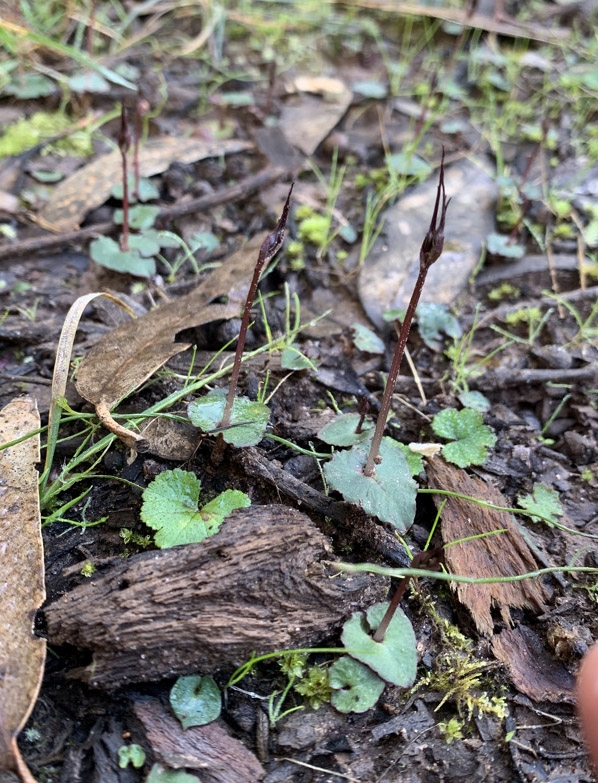 Mayfly Orchids in bud
Mayfly Orchids in bud
The rare Large Gnat Orchids, Cyrtostylis robusta, have started flowering while the smaller species, Small Gnat Orchid, C. reniformis, which is common in the district, is still in small bud.
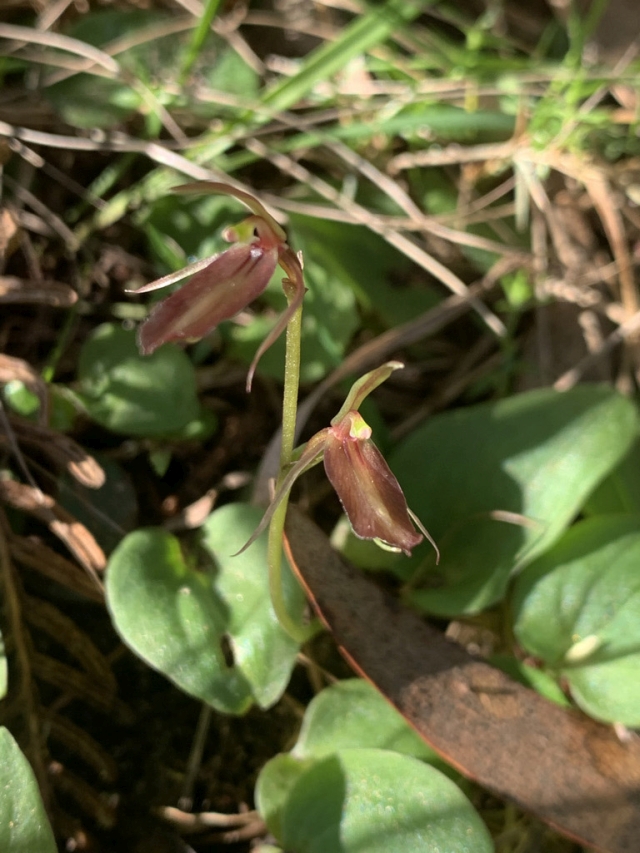 Large Gnat Orchid
Large Gnat Orchid
An interesting find by a visitor to Anglesea was just one Small Helmet Orchid, Corybas unguiculatus flowering in quite a large colony of Small Gnat Orchids at Gum Flat. This area used to be a stronghold for Small Helmets but they have not been observed there for a number of years.
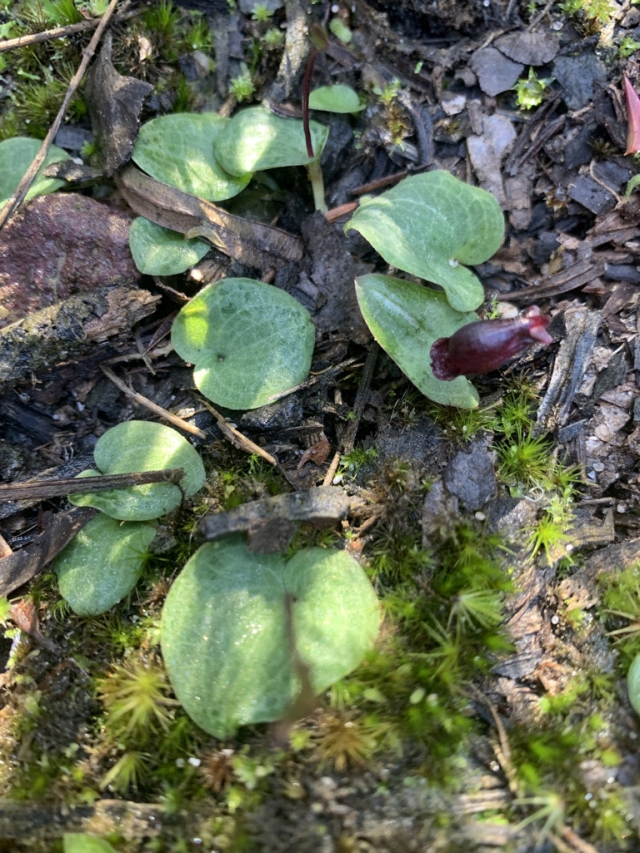 Small Helmet Orchid with Small Gnat Orchid leaves
Small Helmet Orchid with Small Gnat Orchid leaves
The second species of Helmet Orchid to be seen in our area is the Veined Helmet Orchid, Corybas diemenicus, which although tiny is delightful to observe. The dark reddish flower has a flared toothed labellum with a white central area and with the dorsal sepal capping the labellum.
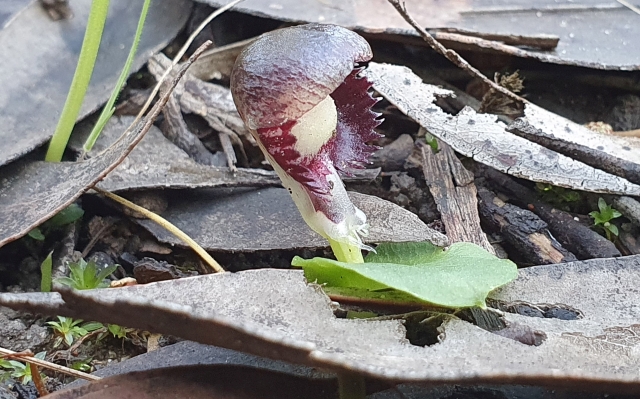 Veined Helmet Orchid
Veined Helmet Orchid
Compared to the Small Helmet Orchid, C. unguiculatus, featured last month, this orchid seems to produce many more flowers. This year we estimate there are over a hundred in the colony at Gum Flats. They appreciate damp conditions, so it seems they have benefited from the recent rains. It is concerning however because apart from a colony that we are aware of on private land in Anglesea this is the only known colony in the district. They were once plentiful near Cecil Track but appeared to disappear following a fuel reduction burn in the area. Apparently the tubers are close to the surface and we assume they may have been destroyed by the fire. They used to also be found at Urquhart Bluff, but although we have searched the area carefully no trace has been found.
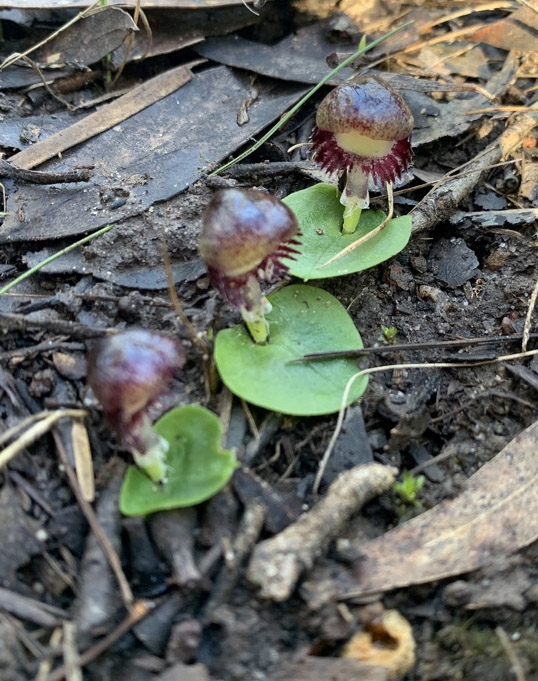 Veined Helmet Orchids
Veined Helmet Orchids
The next Helmet Orchid to see is the more common Slaty Helmet Orchid, C. incurvus, which so far, we have only seen one in flower. Keep a look out for the typical ground hugging rounded leaves and look closely for the tiny flower with an incurved labellum.
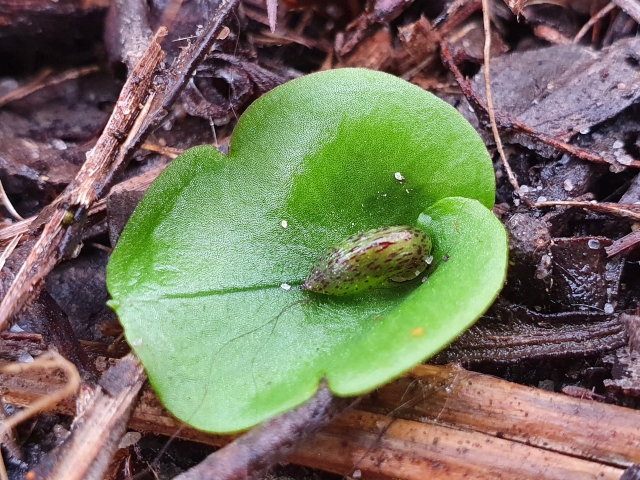 Slaty Helmet Orchid in bud
Slaty Helmet Orchid in bud
In the Tanners Rd area, which was burnt last year, Hare Orchid, Leptoceras menziesii, leaves can be seen as well as many Red Beaks, Pyrorchis nigricans, leaves—though no buds have been seen yet. In the burnt area in Camp Rd Anglesea where the Red Beaks flowered so well last year there are many leaves but again no buds. However buds have been sighted on Teds Track where there has been no fire activity. For some reason they do flower well there each year – just 2 or 3 . There are also a few in bud on Forest Rd and we look forward to seeing them flower if they are not eaten by hungry wallabies or kangaroos.
We also look forward to seeing the first Leopard Orchid, Diuris pardina, and the first Spider Orchids, Caladenia sp., which should appear very soon. Also, Maroonhoods, P. pedunculata, and maybe Bluebeards, Pheladenia deformis, and Blue Fingers, Cyanicula caeralea which all flower in August.
Leaves of Waxlips, Spider Orchids, Leek Orchids, Sun Orchids, and Flying Duck Orchids can be seen throughout the district and hopefully we will enjoy a good spring flowering.
Please make sure you let us know of any unusual sightings you have seen.
All our orchids are documented and photographed in Orchids of the Anglesea District unfortunately now out of print. We have had a few hiccups with the production of the new edition but we can assure you it is well on its way to publication.
Margaret MacDonald margmacmoggs@icloud.com Alison Watson alisonw577@gmail.com